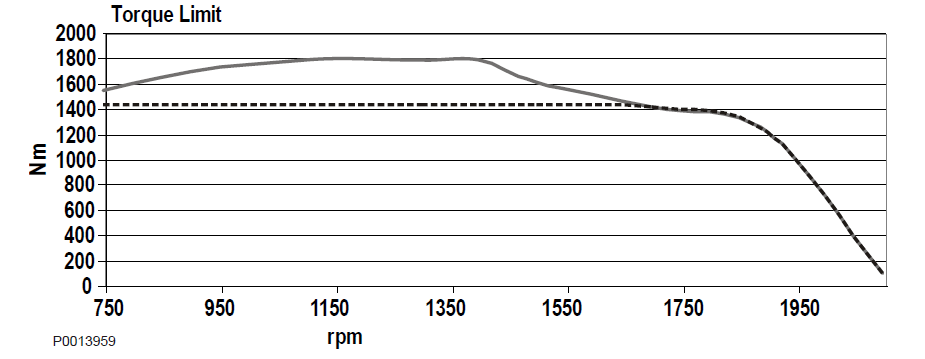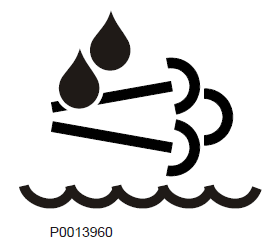There are other possibilities than the VP status/pedal position message in order to control the Volvo engine speed. Torque speed control - TSC1 (0C 00 00 03/11/E6) The TSC1 message has priority over the pedal position that is sent with the VP status message. With the TSC1 message with source address 0x03, 0x11, 0xE6, the engine speed and torque can be continuously controlled.
With the TSC1 message with the source address 0x11 it is possible to limit the available torque or speed from the engine.

Figure 4: The yellow graph shows the available engine torque when the TSC1 signal sets to 80% in the torque limiting factor.
The picture shows an example on how an engine would react when limiting the torque via the TSC1 message.
Start battery test
Whit the fuel disable request in the VP status message, it is possible to perform a start battery test.
Special requirements with EATS
The engines equipped with exhaust after treatment systems have some more requirements regarding which messages that includes error code information.
DEF level
The DEF level is broadcasted on the J1939 bus via
SPN 1761. SPN 1761 will show a value between 0 - 100%
DEF level diagnostics
The DEF level diagnostics are sent via two different SPN numbers. These SPN numbers are SPN 5245 and 5246 and they are included in the message AT1TI (PGN 65110). See table 5 for location of these signals in AT1TI.
SPN | Start byte | Start bit | Length (bits) |
5245 | 5 | 6 | 3 |
5246 | 6 | 6 | 3 |
Table 5: SPN 5245 and 5246 in PGN 65110 (AT1Ti).
If the DEF level is low SPN 5245 will be sent with a value that shows how severe the low level is as described in table 6.
SPN 5245 Value | Severity Level |
1 | DEF/AdBlue level low. Solid signal. |
4 | DEF/AdBlue level empty. Flashing with 1Hz. |
Table 6: SPN 5245 and 5246 in PGN 65110 (AT1Ti).
There are different inducement levels to motivate the operator to not use the engine when the EATS does not work properly. The inducement level active is communicated via SPN 5246 as described in table 7.
SPN 5246 Value | Inducement Level |
3 | Engine derate |
4 | Pre severe inducement |
5 | Severe inducement |
6 | Temporary override of inducement |
Table 7: SPN 5245 and 5246 in PGN 65110 (AT1Ti).
DEF symbol
If a symbol is used in the display for any SCR related SPN, the symbol shown in figure 5 has to be used.

Figure 5: The symbol used for DEF functions.
EMS-2 extra stop
On EMS2 engines the extra stop is level triggered as shown in figure 7. The default setting is “Energized to stop” which means that when there is power on this pin the engine will stop and it will not be able to start until the stop signal is deactivated.
If the parameter “Stop function EMS, energized to” is set to run, there needs to be battery power on this pin in order for the engine to be able to run.

Figure 7: The extra stop functionallety on EMS2 engines.
Diagnostic Function
The diagnostic function monitors and controls that the EMS system functions normally. The diagnostic function has the following tasks:
• Detecting and locating disturbances
• Reporting detection of disturbances
• Providing guidance when fault tracing
NOTICE! With the DCU:n it is possible choose the language that the information is presented in.
If the diagnostic function detects a disturbance in the system, this is reported using fault codes via the instruments.
Both active (unrectified) and passive (rectified) faults are stored in the control unit.
Refer to the “Operation” heading for reading fault codes/fault messages.
All fault codes and fault messages are found in the fault code list, with information about the reason, reaction and measures to be taken. Refer to Fault Code Register.
NOTICE! All instruments are optional.
Effect on engine
Engines are affected differently, depending on the severity of the fault discovered by the diagnostic function.
A fault message in the form of a fault code is always generated when a malfunction is discovered by the diagnostic function.
Engines are affected differently, depending on the severity of the fault:
• The engine is not affected
• Engine goes to idle
• Engine torque is restricted to a certain amount
• Engine is stopped
Active and Inactive Faults
Active faults
At the same time, the fault is stored in the control unit memory. When the fault has been attended to and the ignition is switched off and on again, the fault disappears as active.
DCU (Display Control Unit)
• text !! ENGINE WARNING !! shown on the display.
CIU (Control Interface Unit the diagnostic lamp starts to flash.
• ”Easy Link” instrument- the relevant lamp on the alarm panel lights up- after the diagnostic button has been pressed, the fault code is shown as text on the tachometer display.
Copyright © Guangxi Dingbo Generator Set Manufacturing Co., Ltd. All Rights Reserved | Sitemap
Update cookies preferences